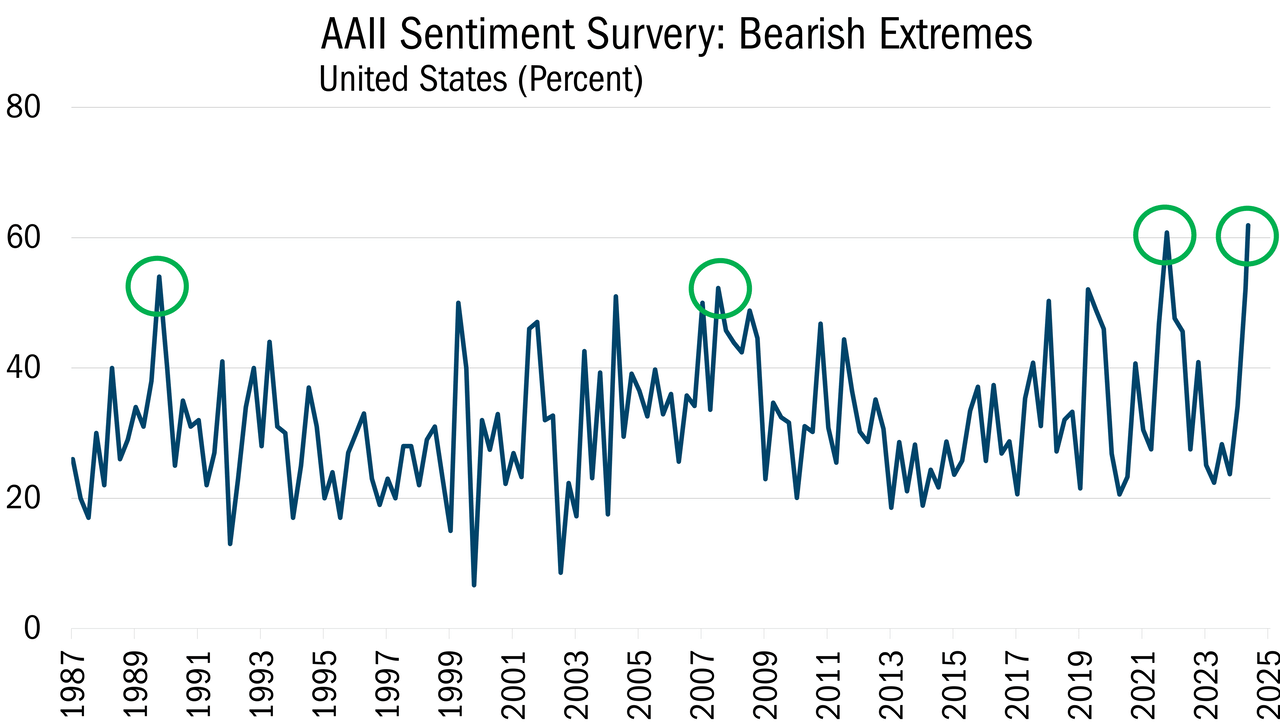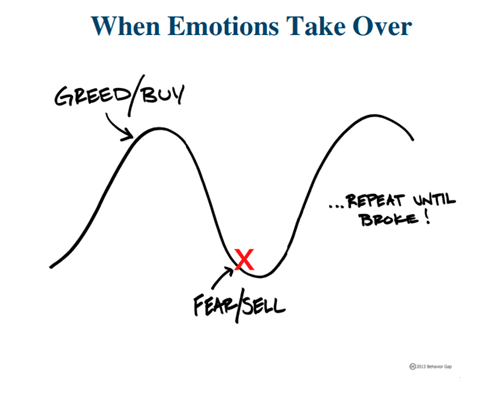“Behind every stock there is a company. Find out what it’s doing.”— Peter Lynch
Sometimes, it’s almost impossible, even for long-term minded investors, to completely ignore the noise. The first quarter was one of those markets.
Nobody — not large institutional investors, advisors, economists, or individuals — really knew what was coming next in the flurry of policy shifts ranging from tariffs to spending cuts at the start of the year. With businesses and consumers expecting more fiscal shoes to drop, many held off making big decisions, reducing the pace of new hiring, investments, and spending in the quarter, leading to a selloff. As you’d expect, the corresponding flight to safety hit small stocks harder, with the Russell 2000® Index (RTY) down around 9.5% in the first quarter, compared with the 4.3% decline for the blue chip S&P 500 Index (SP500, SPX).
There is something, however, that successful value managers know when it comes to navigating times like this. When the macroeconomic picture begins to blur, it often makes sense to focus on the micro. That’s how some of the smartest investors in history, such as Warren Buffett and Peter Lynch, found their success. Lynch famously noted that in every era, there has been an existential fear about the economy, geopolitics, or fiscal policy that seemed as if it might derail the market’s long-term upward trajectory. The mistake that many make is letting those top-down worries drive them out of equities rather than concentrating on the opportunities presenting themselves from a bottoms-up perspective.
At the end of March, bearishness tracked by the American Association of Individual Investors climbed to a reading of 52.2, a level that’s only been reached a few times in recent memory. This amount of fear was last seen in the global financial crisis in 2008-2009 and the recession of 1990.

| Source: Bloomberg. Quarterly, 9/30/1987 to 4/3/2025. The data in this chart represents the American Association of Individual Investors Sentiment Survey and the rise of bearishness over time. All indices are unmanaged. It is not possible to invest in an index. Past performance does not guarantee future results. |
We believe focusing on the micro and understanding the underlying strengths and vulnerabilities of companies in our Strategy helped us navigate the choppy market during the quarter. In our view, the logical response to uncertainty is to think about as wide a range of outcomes as possible, which is what our approach requires us to do. For every company we hold or consider, four price targets are established to weigh both upside potential and downside risks. Those reflect best-case, base-case, downside-risk and max-downside-risk scenarios. By doing so, we try to go into every situation already knowing what to expect should circumstances change for the worse.
This bottoms-up perspective also gives us another advantage: It shows how much value there is in this market and gives us reason to be optimistic. Our holdings in the Heartland Value Fund, for instance, are trading at just 10 times earnings for the next 12 months, representing an earnings yield of 10%. Valuations are just one component of our 10 Principles of Value Investing™, which focuses on identifying attractively priced, well-managed businesses with sound finances and business strategies that will help them grow throughout an entire cycle.
Attribution Analysis & Portfolio Activity
For the quarter, the Heartland Value Fund fell 5.63%, compared with the 7.74% decline for the Russell 2000® Value Index. We outperformed the benchmark not just during the last three months but also over past 1, 3, and 5 years. Stock selection accounted for all our outperformance in the quarter and was particularly strong in Energy, Financials, Technology, Real Estate, and Consumer Discretionary.
During the quarter, we were willing to take what the market was giving us. The conditions may not be ideal, but uncertainty gives rise to fear, bringing about lower stock prices, which provides patient, disciplined investors like us with opportunities.
Recently, we’ve been willing to add to positions in companies where the fundamentals make sense and with promising levels of insider buying to confirm our views. A good example is Columbus McKinnon Corp. (CMCO), which we initially added to our Strategy in the fourth quarter. The company designs, manufactures, and distributes materials, handling products, and systems used in a variety of industrial applications, including lifting, precision conveyance, and linear motion.
Historically, CMCO’s growth has been largely driven by changes in manufacturing activity. A new CEO joined the business in June 2020 with the goal of higher growth and margin applications while increasing the recurring revenue mix. CMCO, however, reported a softer recent quarter due to slowing industrial demand driven by U.S. policy uncertainty. The company also announced a $2.7 billion acquisition of competitor Kito Crosby, which sent the stock plummeting 41% due to uncertainty around execution and an increased leverage profile of 4.8x upon closing.
We believe Columbus McKinnon offers investors a compelling risk/reward case and a strong catalyst as it seeks to reduce leverage and improve the growth and margin profile of the consolidated business. Management, which has been aggressively purchasing the stock in the open market during the recent sell-off, is targeting mid-20% EBITDA margins upon integration. That’s up from an estimated 15.5% in FY25 pre-acquisition. At the end of the quarter, the stock was trading at about $17 a share. Our current target price target of $54 would imply a valuation of 10.5 times Enterprise Value to EBITDA. Upon execution of the acquisition, however, we believe CMCO should be treated similarly to its industrial peers trading an at average of 12x EV/EBITDA.
While Columbus McKinnon is an example of a stock that was negatively impacted by policy uncertainty (at least temporarily), PotlatchDeltic (PCH) is a company that could benefit from recent policy changes.
Potlatch, a timber REIT that focuses on harvesting sawlogs and producing wood products, has been in our portfolios for quite some time. When we first entered this position, it stood out as a domestic provider of homebuilding materials. That remains a highly relevant point, given the supply gap of housing in the United States and tariffs established by the Trump administration on Canadian timber products.
The new levies, on top of those already in place, brings the total tax on Canadian lumber to over 50%. As PCH is the only American wood products company that manufactures entirely in the U.S, it is likely to be a primary beneficiary of the rising cost of imported timber. Potlach’s harvest volume is mostly comprised of Southern Yellow Pine, which may not be a perfect substitute in terms of quality compared to trees historically imported from Canada but will likely be preferred by the market in terms of cost. We value PCH, which is currently trading at around $45 per share, with a target price of $54.
Potlatch and Columbus both demonstrate that fundamentals aren’t enough. Our 10 Principles of Value Investing™ demand there be a strong catalyst for recognition to justify holding a stock. Last quarter, we highlighted Delek (DK), an oil refiner that produces petroleum products for the transportation and industrial industry.
In the first quarter, we exited the stock. The risk-reward on Delek still looks compelling, but we’re not confident that the catalyst is still there. Management attempted to unlock the sum of the parts of the combined company, but then took a significant write-down of assets. Also, DK’s earnings outlook continues to deteriorate. Given this, we decided to use the proceeds of exiting the stock to add to positions in which we have greater conviction.
On a positive note, as the Trump administration’s policies and global jitters rattled the markets, investors flocked to precious metals. Gold closed the quarter at a record high of around $3,150 per ounce while silver and copper advanced around 20% for the period. In a dollar-debasing environment, owning physical gold and other metals is receiving increased interest from central banks worldwide as well as an increasingly wide range of investors, both young and old.
For some time we have been supportive of holding hard asset producers such as well financed, profitable miners and their allied providers. A standout performer has been a Canadian producer, New Gold (NGD), owner of the Rainy River gold mine and New Afton copper/gold mines.
The stock has more than doubled this past year, buoyed by increased production, higher grades and reserves, plus lower costs providing a substantial increase in free cash flow. With all-in sustaining costs (AISC) less than $1,400 per ounce, NGD is positioned to prosper. However, now priced in excess net asset value, NAV, we have taken advantage of increased interest and higher prices by trimming holdings. The proceeds were utilized to increase our holdings in two other miners which our research indicates are priced at 50% discounts to their NAV’s.
Outlook
This is what active management is all about. The two great emotions in investing are greed and fear. Within less than two quarters, this market swung from one to the other. Will tariffs lead to a slowdown, recession, or something worse? Nobody knows with absolute certainty. But if there’s anything we’ve learned in the 40+plus years of managing the Value Fund, it’s the folly of trying to guess what’s going to transpire at the macro level in the short-term.
What really matters is being able to control your emotions and focus on the micro over the long run in conjunction with a risk management mindset. When you do that and follow Peter Lynch’s advice by getting to know what each of your companies is doing, you will discover how much value there is for those willing to do the research. We believe today’s emotionally charged extreme is setting up opportunities for the active, value-based investor.

Fundamentally yours,
The Heartland Investment Team
Will Nasgovitz, CEO and Portfolio Manager
Bill Nasgovitz, Chairman and Portfolio Manager
Fund Returns (3/31/2025)
| Since Inception (%) | 20-Year (%) | 15-Year (%) | 10-Year (%) | 5-Year (%) | 3-Year (%) | 1-Year (%) | YTD* (%) | QTD* (%) | |
|---|---|---|---|---|---|---|---|---|---|
| Value
Investor Class (MUTF:HRTVX) |
10.98 | 6.66 | 7.76 | 6.24 | 19.69 | 5.78 | 2.30 | -5.63 | -5.63 |
| Value
Institutional Class (MUTF:HNTVX) |
11.06 | 6.82 | 7.93 | 6.40 | 19.87 | 5.94 | 2.48 | -5.57 | -5.57 |
| Russell 2000® Value | 10.16 | 6.80 | 8.19 | 6.07 | 15.31 | 0.05 | -3.12 | -7.74 | -7.74 |
|
*Not annualized Source: FactSet Research Systems Inc., Russell®, and Heartland Advisors, Inc. The inception date for the Value Fund is 12/28/1984 for the investor class and 5/1/2008 for the institutional class. Past performance does not guarantee future results. Performance represents past performance; current returns may be lower or higher. Performance for institutional class shares prior to their initial offering is based on the performance of investor class shares. The investment return and principal value will fluctuate so that an investor’s shares, when redeemed, may be worth more or less than the original cost. All returns reflect reinvested dividends and capital gains distributions, but do not reflect the deduction of taxes that an investor would pay on distributions or redemptions. Subject to certain exceptions, shares of a Fund redeemed or exchanged within 10 days of purchase are subject to a 2% redemption fee. Performance does not reflect this fee, which if deducted would reduce an individual’s return. To obtain performance through the most recent month end, call 800-432-7856 or visit heartlandadvisors.com. An investor should consider the Funds’ investment objectives, risks, and charges and expenses carefully before investing or sending money. This and other important information may be found in the Funds’ prospectus. To obtain a prospectus, please call 800-432-7856 or visit heartlandadvisors.com. Please read the prospectus carefully before investing. As of 3/31/2025, Columbus McKinnon Corporation (CMCO), New Gold Inc. (NGD), and PotlatchDeltic Corporation (PCH) represented 1.06%, 1.54%, and 0.97% of the Value Fund’s net assets, respectively. Delek US Holdings, Inc. (DK) is unowned by Heartland Funds, Inc. Statements regarding securities are not recommendations to buy or sell. Portfolio holdings are subject to change. Current and future portfolio holdings are subject to risk. The Value Fund invests primarily in small companies selected on a value basis. Such securities generally are more volatile and less liquid than those of larger companies. Value investments are subject to the risk that their intrinsic value may not be recognized by the broad market. The Value Fund seeks long-term capital appreciation through investing in small companies. The above individuals are registered representatives of ALPS Distributors, Inc. The Fund’s performance information included in regulatory filings includes a required index that represents an overall securities market (Regulatory Benchmark). In addition, the Fund’s regulatory filings may also include an index that more closely aligns to the Fund’s investment strategy (Strategy Benchmark(s)). The Fund’s performance included in marketing and advertising materials and information other than regulatory filings is generally compared only to the Strategy Benchmark. The Heartland Funds are distributed by ALPS Distributors, Inc. The statements and opinions expressed in this article are those of the presenter(s). Any discussion of investments and investment strategies represents the presenters’ views as of the date created and are subject to change without notice. The opinions expressed are for general information only and are not intended to provide specific advice or recommendations for any individual. The specific securities discussed, which are intended to illustrate the advisor’s investment style, do not represent all of the securities purchased, sold, or recommended by the advisor for client accounts, and the reader should not assume that an investment in these securities was or would be profitable in the future. Certain security valuations and forward estimates are based on Heartland Advisors’ calculations. Any forecasts may not prove to be true. Economic predictions are based on estimates and are subject to change. There is no guarantee that a particular investment strategy will be successful. Sector and Industry classifications are sourced from GICS®.The Global Industry Classification Standard (GICS®) is the exclusive intellectual property of MSCI Inc. (MSCI) and S&P Global Market Intelligence (“S&P”). Neither MSCI, S&P, their affiliates, nor any of their third party providers (“GICS Parties”) makes any representations or warranties, express or implied, with respect to GICS or the results to be obtained by the use thereof, and expressly disclaim all warranties, including warranties of accuracy, completeness, merchantability and fitness for a particular purpose. The GICS Parties shall not have any liability for any direct, indirect, special, punitive, consequential or any other damages (including lost profits) even if notified of such damages. Heartland Advisors defines market cap ranges by the following indices: micro-cap by the Russell Microcap®, small-cap by the Russell 2000®, mid-cap by the Russell Midcap®, large-cap by the Russell Top 200®. Because of ongoing market volatility, performance may be subject to substantial short-term changes. Dividends are not guaranteed and a company’s future ability to pay dividends may be limited. A company currently paying dividends may cease paying dividends at any time. There is no assurance that dividend-paying stocks will mitigate volatility. Russell Investment Group is the source and owner of the trademarks, service marks and copyrights related to the Russell Indices. Russell® is a trademark of the Frank Russell Investment Group. Data sourced from FactSet: Copyright 2025 FactSet Research Systems Inc., FactSet Fundamentals. All rights reserved. Heartland’s investing glossary provides definitions for several terms used on this page. |
Original Post
Editor’s Note: The summary bullets for this article were chosen by Seeking Alpha editors.
Read the full article here


